State of the Part: SoC Manufacturers
by Jarred Walton on August 19, 2014 6:00 AM EST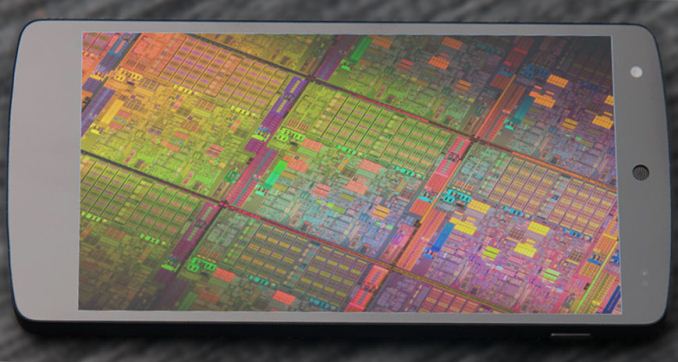
Introduction
A few years ago, it seemed a new System-On-Chip (SoC) design using an ARM-based architecture would pop up every other week. While competition can be great, with so many of the designs offering similar core features and the need to provide support for the products, over time the major players in the ARM SoC market have shifted and consolidated (e.g. Texas Instruments has exited the Application Processor space). There are still plenty of companies that ship SoCs, but some of these are lower end offerings that can't really compete except on price, leaving us with a few major players.
Depending on whom you wish to include/exclude, there are anywhere from four to eight SoC manufacturers still in the game, with three of them mostly catering to the budget sector. We could also include ARM as a company, but since they don't really manufacture any parts we'll leave that for a separate article.
Before we get to the manufacturers, let's quickly go over the pertinent items to know for any SoC. The main functionality of any SoC is going to come from the CPU cores, where modern designs typically use either two or four cores, with some offerings including up to eight cores -- four lower power cores that offer better battery life with four higher performance cores for when there's work to be done. Next to the CPU cores in importance is the GPU, the graphics processor, and again you can find SoCs with multiple GPU "cores" combined to improve graphics performance (e.g. MP1 for one core, MP2 for two, and so on). Finally, it's useful to know the manufacturing process for an SoC, as lower numbers generally mean smaller, more power efficient chips. We've had variations of 28nm manufacturing for a few years now, with the state-of-the-art next generation SoCs now moving to 20nm for most companies.
Ultimately, what it comes down to is the end user experience, which is a very broad topic and out of the scope of this article. The pace of technology in smartphones and tablets has been pretty brisk, however, so anything more than a year old can end up feeling quite sluggish, and after two years most users are ready for an upgrade. Most of the top SoCs right now are 28nm designs with at least two CPU cores, but not all cores are created equal, so this is another topic we'll address in a future piece.
The general idea is that if you're like most people and live on the two-year upgrade cycle for smartphones, the best time to upgrade is usually right after a major technology advance. Roughly two years ago we started seeing the first ARM Cortex-A15 designs along with Apple's competing A6 "Swift" architecture, and while there are faster devices today the smartphones and tablets using those chips are still able to deliver a decent user experience. We're now on the brink of the next generation of SoCs, thanks to the shift to the 20nm manufacturing process along with ARM's new 64-bit Cortex-A53 and Cortex-A57 designs, so if you've been holding off upgrading the next few months should prove very enticing. Of course we'll still have to wait for early 2015 before many of the devices using the new SoCs are available for purchase.
Without going into too much detail, here's the short list of significant SoC manufacturers, with a brief discussion of their current and upcoming parts. In the near future we'll have separate articles going into more detail on the various models and technology for each company, as well as some recommendations in terms of performance and the overall user experience. This is intended as a short high-level overview of the companies to get us started.
Qualcomm
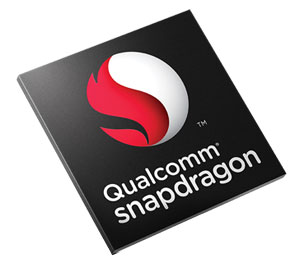 Qualcomm is one of the biggest players in the SoC market, and their designs are in many of the leading Android devices. All of the current Qualcomm SoCs are sold under the Snapdragon brand, and there are multiple performance segments (i.e. the Snapdragon 200, 400, 600, and 800 series). Qualcomm has had several custom-designed ARM architectures, with the latest being Krait (with multiple variations of Krait as well). Most of the lower tier parts are dual-core Krait designs with the higher-end 600 and 800 series being quad-core Krait offerings. Their current halo parts are in the 800 family, with the 800, 801, and 805 all presently shipping, but even within the same model number there are multiple configurations available (e.g. with or without cellular baseband options).
Qualcomm is one of the biggest players in the SoC market, and their designs are in many of the leading Android devices. All of the current Qualcomm SoCs are sold under the Snapdragon brand, and there are multiple performance segments (i.e. the Snapdragon 200, 400, 600, and 800 series). Qualcomm has had several custom-designed ARM architectures, with the latest being Krait (with multiple variations of Krait as well). Most of the lower tier parts are dual-core Krait designs with the higher-end 600 and 800 series being quad-core Krait offerings. Their current halo parts are in the 800 family, with the 800, 801, and 805 all presently shipping, but even within the same model number there are multiple configurations available (e.g. with or without cellular baseband options).
The existing parts use either a 28nm LP or 28nm HPm process, but more recently Qualcomm has announced the Snapdragon 808 and 810, which move to a 20nm HPm process and use ARM's Cortex-A57/A53 64-bit cores in a 2+4/4+4 configuration, with Adreno 418/430 graphics. The shrink in process technology is something we should see from all of the major players in the coming months, with the benefits being potentially lower power and/or higher performance coupled with smaller chip sizes.
In the near term, Qualcomm also has their new 410 and 610 Snapdragon parts that will be their first 64-bit SoCs. The 410 appears to be shipping in certain markets, and the 610 should show up in Q4'2014 devices. Meanwhile, the 810 should start shipping in devices in the first half of 2015 and will be the halo product from Qualcomm, with 808 following shortly after. Qualcomm has not yet announced a custom designed 64-bit architecture, but that will likely come later in 2015.
Apple
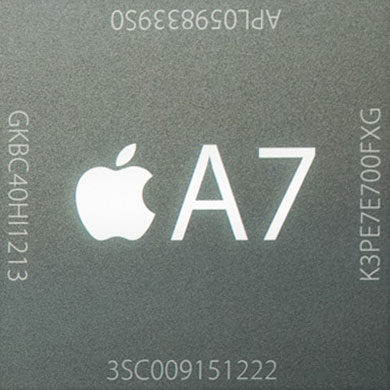 Apple is next in the list, though really the top two positions are hotly contended and many would place them first. Either way, Apple needs little in the way of introduction. Largely responsible for the new paradigm in touchscreen smartphones thanks to their iPhone, the performance of Apple's devices has continued to increase at a rapid pace. Apple also has the advantage of running their own software with iOS, which potentially gives them an advantage over other companies that utilize Android. While earlier iPhones used designs largely built by other companies, Apple began designing their own ARMv7 architecture with the A6 in 2012.
Apple is next in the list, though really the top two positions are hotly contended and many would place them first. Either way, Apple needs little in the way of introduction. Largely responsible for the new paradigm in touchscreen smartphones thanks to their iPhone, the performance of Apple's devices has continued to increase at a rapid pace. Apple also has the advantage of running their own software with iOS, which potentially gives them an advantage over other companies that utilize Android. While earlier iPhones used designs largely built by other companies, Apple began designing their own ARMv7 architecture with the A6 in 2012.
The latest generation A7 SoC was introduced about a year ago with the iPhone 5S in September 2013 and has since found its way into the iPad Mini Retina and iPad Air. The A7 features a dual-core 1.3-1.4GHz Apple-designed processor codenamed Cyclone, running the ARMv8 instruction set, making it the first shipping 64-bit SoC. Short-term that may not be a huge deal, but long-term it paves the way for future devices. We believe the GPU in the A7 is a PowerVR G6430 200MHz GPU (four cluster MP4 configuration). The A7 is manufactured on Samsung's 28nm process and uses 1GB of memory.
Given Apple's history, we can expect some sort of update at the next iPhone event, rumored to be on September 9. Most think the next Apple chip will be called the A8 and will likely move to a 20nm process technology, allowing for a generational leap in performance. We might finally see an iOS device with 2GB RAM.
Samsung
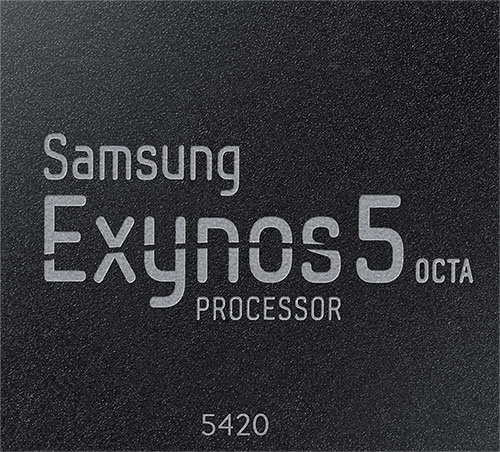 In terms of volume if not performance, Samsung comes next in our hierarchy, and they've long been a player in the SoC market, going back as far as the early 2000s with some of their chips; they were also the SoC provider for the original iPhone in 2007. Samsung has numerous smartphones and tablets available, and while many use Samsung SoCs there are also Qualcomm SoCs in some models. Their current SoC designs belong to the Exynos family, which has been around since 2011.
In terms of volume if not performance, Samsung comes next in our hierarchy, and they've long been a player in the SoC market, going back as far as the early 2000s with some of their chips; they were also the SoC provider for the original iPhone in 2007. Samsung has numerous smartphones and tablets available, and while many use Samsung SoCs there are also Qualcomm SoCs in some models. Their current SoC designs belong to the Exynos family, which has been around since 2011.
The top performance Exynos SoC right now is the 5800, also called the Exynos 5 Octa, a 4+4 big.LITTLE implementation with four faster Cortex-A15 cores and four slower but more power efficient Cortex-A7 cores, paired with a Mali-T628 GPU. The Exynos 5 Octa (and Hexa if we include the 5260) use Samsung's 28nm HKMG process, but there's a new Exynos 5430 (used in certain models of the upcoming Samsung Galaxy Alpha) that has a similar configuration and uses a new 20nm HKMG process. We'll likely see more 20nm Samsung SoCs in the coming months, and with most companies shifting to the new 64-bit Cortex-A57/A53 we can expect Samsung to do the same.
NVIDIA
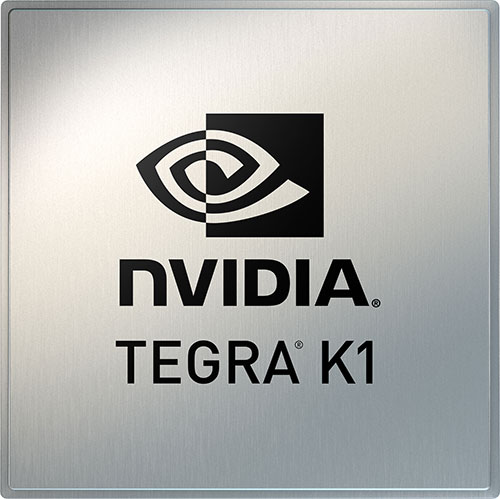 NVIDIA is a familiar name for PC enthusiasts, and they're sort of the reverse of Samsung right now: higher performance but lower volumes shipped. Given the growing popularity of tablets and smartphones, there's little surprise that NVIDIA is also working to gain (and maintain) a foothold in the mobile sector. Their latest SoC is the Tegra K1, found in the SHIELD Tablet and Acer's new Chromebook.
NVIDIA is a familiar name for PC enthusiasts, and they're sort of the reverse of Samsung right now: higher performance but lower volumes shipped. Given the growing popularity of tablets and smartphones, there's little surprise that NVIDIA is also working to gain (and maintain) a foothold in the mobile sector. Their latest SoC is the Tegra K1, found in the SHIELD Tablet and Acer's new Chromebook.
Tegra K1 pairs a 192-core Kepler-derived GPU with one of two CPU options. The first is a quad-core Cortex-A15 R3 design that's similar to the processor used in the Tegra 4, while an upcoming variant of the K1 will use a dual-core 64-bit Denver CPU designed by NVIDIA. Considering the most successful ARM SoCs are going the custom-logic route (e.g. Apple's Cyclone and Qualcomm's Krait are custom designs that use the ARMv8 and ARMv7 instruction sets rather than simply using Cortex-A15), NVIDIA hopes to improve performance while reducing power, among other things.
While the shipping K1 uses four A15 cores and is manufactured on a 28nm process, the Denver version could move to 20nm, but NVIDIA hasn't officially announced the process for the Denver K1. The Tegra K1 is currently one of the fastest (if not the fastest) shipping SoCs, but many of the next generation SoCs have not yet launched so this could very well change in the next month or two. Looking forward, the successor to the Tegra K1 is currently codenamed Erista and is expected to pair a Maxwell-based GPU with Denver CPU cores, but that part won't begin production until some time in 2015 so it's a ways off.
Intel
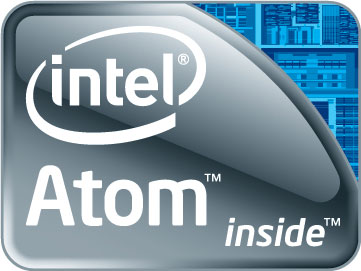 The final major player in terms of higher performance SoCs is Intel, another company that needs little introduction. Unlike everyone else on this list of SoC manufacturers, Intel is using their own custom architecture running the x86 instruction set instead of ARMv7 or ARMv8. Where x86 has proven to be a juggernaut in the PC space, in the mobile world where every device gets a customized software build it has not been nearly as useful – and some might even call it a handicap, though these days the difficulty of decoding x86 is relatively small. Intel has been trying to stake a claim in the mobile sector, and after a few initial forays that didn't accomplish much, their latest Atom SoCs have seen a moderate amount of use.
The final major player in terms of higher performance SoCs is Intel, another company that needs little introduction. Unlike everyone else on this list of SoC manufacturers, Intel is using their own custom architecture running the x86 instruction set instead of ARMv7 or ARMv8. Where x86 has proven to be a juggernaut in the PC space, in the mobile world where every device gets a customized software build it has not been nearly as useful – and some might even call it a handicap, though these days the difficulty of decoding x86 is relatively small. Intel has been trying to stake a claim in the mobile sector, and after a few initial forays that didn't accomplish much, their latest Atom SoCs have seen a moderate amount of use.
The currently shipping Atom SoCs are 22nm devices, codenamed Bay Trail. You can find them in NAS and other products, but we're mostly concerned with the tablet and smartphone spaces for this overview. The Merrifield and Moorefield platforms (Atom Z34xx/Z35xx) remain at 22nm and use the same core Silvermont CPU cores as Bay Trail, except with PowerVR 6 G6400/G6430 graphics.
Looking to the future, the platform that may finally give Intel a real leg up on the competition likely won't come out until early to mid 2015. That's the Cherry Trail platform, which will upgrade the CPU cores to Airmont and move to Intel's 14nm process, delivering better performance in a lower power package. We've been saying "wait for the next Atom update" for a while, but on paper at least Cherry Trail looks very promising – it's the first Atom to ship on Intel's latest process technology without waiting a year or more, and it's the second Atom design after Intel's commitment to begin updating the Atom platform on a yearly basis.
MediaTek
Moving over to the budget players, there are at least two that warrant mentioning. MediaTek has been around for a while now, though like most SoC companies they didn't really get into the ARM and Android space until 2009/2010. Starting in 2013, however, MediaTek managed a ton of design wins…but all of the wins are almost exclusively in lower performance, second tier parts. In terms of strict volume, MediaTek likely ships as many (or more) SoCs as the biggest companies, and they are a major provider of SoCs in the Chinese market. Not surprisingly, MediaTek devices tend to be budget friendly products, though that often means compromises in other areas as well.
Their current top-tier SoCs use quad-core, hexa-core, and even octa-core Cortex-A7 designs with Mali-400/450 graphics (up to MP4 configurations). Like the PC world, however, throwing more cores on a chip can only get you so far, and the big.LITTLE configurations seem like a better solution than eight Cortex-A7 cores. MediaTek does have some higher performance SoCs with big.LITTLE A17/A7 starting to ship to device manufacturers (e.g. MT6595), though these are not yet in shipping devices. The MT6732 part has a quad-core Cortex-A53 CPU with Mali-T760 graphics, while MT6752/MT6795 move to octa-core A53 with Mali-T760/PowerVR G6200 graphics. The A53 is sort of the 64-bit equivalent of the A7 where the A57 is the higher performance 64-bit part, but A53 could end up delivering a nice blend of performance and efficiency.
Allwinner
Allwinner Technology has many similarities to MediaTek. They've been around since 2007 but their earlier products were largely forgettable. In 2011 they became an official ARM licensee, and since then they've gained some popularity as a budget SoC provider. Their latest products include the quad-core Cortex-A7 based A33, which runs at up to 1.5GHz and includes a Mali 400 MP2 GPU. The A33 is marketed as "the first $4 quad-core tablet processor", and you will likely find this SoC in sub-$100 tablets; performance as you might expect largely follows pricing, but like MediaTek they can still do a huge volume thanks to their cost advantage.
Their fastest announced product is the new A80 SoC, which features an octal-core big.LITTLE configurations (four Cortex-A7 and four Cortex-A15 cores) with a PowerVR G6230 GPU. It's currently shipping in China in the Onda V989, a $200 tablet with a 9.7" 2048x1536 display. As far as manufacturing processes go, the A33 uses 40nm while the A80 uses 28nm HPM.
Closing Comments
There are other SoC vendors we could mention as well. RockChip is right there with Allwinner and MediaTek vying for market share in budget products, for example. They even have the RK3288, a quad-core Cortex-A17 part with Mali-T764 GPU, which should provide decent performance, which is starting to ship in some markets. Let's also not forget their strategic agreement with Intel, which is interesting to say the least. We could also include AMD with their Mullins APU from the PUMA family, which like Intel uses an x86 CPU core designed in-house by AMD. AMD is also an ARM licensee, and they might look to bring alternative SoCs to market using ARM instructions sets instead of x86.
The remaining players are small enough that it's difficult for them to compete with the bigger names. After all, if you're just licensing the same core architectures for the CPU and GPU as everyone else, you can't really offer better performance; all you can do is compete on price. Sometimes that's enough, but the real news in the SoC space is likely going to come from the companies doing their own custom logic.
If we group all the companies shipping vanilla ARM designs under ARM (e.g. MediaTek, Allwinner, RockChip, and even Samsung), that still leaves us with Qualcomm, Apple, NVIDIA, and Intel doing custom logic. It's difficult to imagine any of those companies bowing out right now, and Samsung is a big player as well, which means we'll likely continue to see the "Big Five" SoC companies duking it out in the smartphone and tablet sectors. And while they continue nipping at the market share in the PC laptop/desktop space, they still have to worry about giving up ground to even more budget friendly devices from the likes of MediaTek and Allwinner.










94 Comments
View All Comments
JarredWalton - Tuesday, August 19, 2014 - link
Agreed. Samsung is really looking like the biggest risk, considering they're doing similar designs to MediaTek. But then, Samsung actually has fabs, making them harder to kill. I'm honestly not sure who will be the next big name to fall. TI wasn't all that surprising, but of the "Big Five" who looks weakest? Intel is still trying to become a bigger player, but they've got big pockets that can support Atom while they try to gain market share. The same goes for NVIDIA, though not quite to the same level and NVIDIA is doing more competitive designs IMO. The reality is that anyone who exits the SoC space at this point stands in danger of disappearing altogether in the next decade.jjj - Tuesday, August 19, 2014 - link
The difficult part seems the be the modem now so unless ARM or someone else licenses a killer baseband,that's what will kill the next one.There is this myth about costs but if you look at ARM itself they spend just 80 million + per quarter on R&D so it's not that much for some players out there. Even rumors about Google making a custom core for server don't seem all that crazy if you realize that costs might not be that huge.
As for being out for good, that's not true,there will be transitions to new form factors ( like glasses or w/e will replace the smartphone) and maybe major changes in connectivity (mesh networks maybe) so there can be room for disruption soon-ish.
There is also Project Ara that could somewhat liberalize the market and allow for smaller players to compete Maybe it could even go the opposite way of integration, How about a quad SLI phone lol?
BMNify - Tuesday, August 19, 2014 - link
Yeah, its a bit hard to predict such things but bound to happen to some major players in few years. Samsung is worried not just for their SoC business but their most important money printing business: Smartphones :)Already Xiaomi (Big Qualcomm 800/801 and mediatek customer) has dislodged Samsung as the largest smartphones seller in China with Lenovo and Huawei being other big threats and they sell quality stuff at low prices, just check out Xiaomi Mi3, all premium components at low-end prices, selling for roughly $230 in India and is sold out most of the times, hope you can contact and get a review-unit from unofficial resellers like Xiaomishop who gave gsmarena a review unit or maybe contact Hugo Barra directly on Google plus/twitter, he is very active on social media :)
Also, Micromax (big mediatek customer) in India has come very close to Samsung in smartphone marketshare and with the recent launch of Asus Zenfone 4,5,6 and Xiaomi smartphones, the sales and marketshare for Samsung will be a big problem in few years.
Funfact, Intel got a big design win in the form of Asus Zenfone series, the entire series is based on intel atom platform and is selling quite well, they sold 40000 units within 4 days of launch in India and after that they are constantly sold out eventhough they are bringing 15k-20k units every week.
Rama TT - Sunday, August 24, 2014 - link
*Agreed that companies like Xiaomi and Motorola are giving nightmares to the more established brands but that’s not to say that these brands will slowly lose all their value. For example despite reporting a serious drop in profits Samsung did manage to improve its revenue in the US and the Samsung Galaxy S5 sales in the US have been 50% more than the Samsung Galaxy S4 sales of yesteryear. The same thing was being said about Apple a few years ago but still despite losing hefty market shares most quarter Apple still manages to post more profits than any other manufacturer. Many a times market share does not mean everything profits also matter.*As I said despite profits being 25% less for Samsung they still manged to earn more than any other Android vendor in the market. In fact other Android vendors hardly earn anything. The total combined profits of Apple and Samsung are almost 105% or so. Yeah its 105% and no I am not drunk the extra 5% come into picture if you consider the losses companies like LG/Sony/HTC made a few quarters ago. Companies like Xiaomi and Micromax hardly manage to earn any profits. Take Xiaomi for example they are selling devices at almost cost price and hardly any profit on hardware sales. You can’t expect companies like Samsung to start competing at those prices because they spend billions on advertising and R&D and their major source of revenue is hardware profits.
*In my opinion companies like Samsung and LG will lose market share rather than reducing prices to the level of Xiaomi which are not manageable by them or rather which would not be enough for their expenses. I will readily accept that in future companies like Samsung will lose market share in countries like India and China to some extent but then to the market share which they are losing are to the companies who are hardly making any profit. And even though Samsung loses market share in India and China they will still manage to do well in countries like US/Western Europe/South Korea/Japan etc etc. In developed countries like US for example I don’t think companies like Xiaomi will be able to challenge the might of Samsung.
*In the US market the contract system is followed where carriers subsidize the cost of devices and the 900$ or so iPhone or Galaxy S5 over there “”appears”” like 200$ in the US. Although carriers manage to recover the cost over the 2 period contract but still the consumer has a sense of false belief that he is only paying 200$ for the device. Now in such a market if Xiaomi comes with even a 230$ Xiaomi Mi 3 people would “”believe”” its expensive. Although off contract is becoming popular in US the rule of the thumb is contract and as long as contract systems prevail which I guess they will don’t expect iPhones or Galaxy to lose any ground in US.
*On the other hand in countries like US the success of a device very much depends on the carrier relations a particular company has with a carrier because of the contract nature followed over there. Carriers don’t openly provide every device on contract. Many a times only devices which they feel have the potential of doing well are sold on contract. In case of Xiaomi as I have said before they really don’t manufacture devices in bulk and given the people of US hardly know about the brand initial demand will as usual be low and not much of the public will warm up to the device initially. Carriers know this and won’t stock the device. If sold on full retail price the Mi 3 would cost at least 230$ in the US which is 30$ less than the iPhone 5S or so and despite how good Mi 3 is its definitely no where near the 5S for the very least and even the most tech savvy wont go for Mi 3 for just saving 30 bucks. I know that overall on contract the iPhone 5S would end being expensive but still how many people over there would actually figure out this and even for contracts several theories are present. Some people say its cheaper some say expensive. But anyhow as of now and the foreseeable future contracts are to remain in US.
*Next people in US are not as poor as other developing countries. People over there earn well and can very well afford expensive phones. But still this is more of a personal belief rather than a good point.
*Next up is litigation and patent wars. US is a country with very strict patent laws and no matter how much I like Xiaomi I won’t refrain from saying that they copy Apple. In a very worse manner that too. Its visible all over their products. If Xiaomi were to ever enter US and gain traction I am pretty sure Apple is gonna sue the shit out of them. They did it with Samsung and won’t spare Xiaomi. At least Samsung was earning enough to face the 1 billion $ of fines they have seen from Apple I don’t think Xiaomi posses that kind of wealth that they can suffer litigation. What’s even worse is that Xiaomi copies Apple even more than Samsung then the litigation fee can also be equally high.
*Next marketing matters a lot in US. Both Samsung and Apple have big marketing budgets and companies like Xiaomi don’t even spend on marketing in a commercial manner let alone putting up an Ad during Super Bowl or something. Companies like Motorola LG and Sony which have less marketing budgets often end up as losers and to be truthful for the past several quarters most manufacturers except Samsung and Apple are losing market share in the US and its not because Samsung and Apple are coming up with some really innovative products. NO!!. In fact the G2 HTC One M7 and even Moto X were far better than S4 but still it all went in vain just because these manufacturers like LG HTC and Motorola did not have a marketing budget as good as Samsung.
* As far as I have seen in the electronics Industry the cheapest wins.”jo sasta hai woh bikta hai”. The TV industry and the PC industry are very good examples of the same. The TV once a cash cow for Sony is now Samsung’s field. Same way Lenovo dominated the PC and lapotop industry. But then again PC and TV are mostly individual products sold separately. For example in the TV industry you still don’t have DTH operators subsidizing the cost of TVs same way broadband providers don’t subsidize the cost of laptops even in nations like US that’s why did the once mighty and premium players fell all over the world. In short the product and services did not share any relation in the PC and TV industry.
*The smartphone industry however is different in US etc etc as long as carrier subsidies continue I don’t think its gonna be a challenging way for Apple and Samsung.In the smartphone industry of US etc you have services and products linked. In India you do not have any kind of meaningful subsidies and that’s why do I expect the branded players to lose market share. Even in China the operators are starting to cut down subsidies.
* Even if we leave all this as I said only few players are making serious money in the smartphone market.The countries like US Japan etc where high end smartphones are sold the profit made on every handset is almost triple the cost of say a 5k handset like Samsung Galaxy Star Duos. Losing market share would not mean much to Samsung and LG as long as they lose it to players who are not making money.Just remember for every China there is a US. For every India there is Canada. For every Vietnam there is Japan. Even if manufacturers lose market share in India CHina etc they still have other developed countries to look forward to.
Rama TT - Monday, September 1, 2014 - link
You are a stupid guy from India right? Look at my comment below to know the actual truth. Losing market share means nothing to Samsung. Even companies like Xiaomi and Micromax are hardly able to make any money on the millions or so smartphones which they happen to sell.fm123 - Tuesday, August 19, 2014 - link
Ultimately it comes down to IP and a bit of market luck/timing. Those with IP in CPU, GPU, and LTE have a head start on those who don't. Fab technology seems to help too. Because time to make a custom CPU is pretty long and costly, and everyone else competes on stock ARM designs at the lower price points. I'm not sure Samsung will be making a custom design any time soon, as they don't have much CPU/GPU design history.LiviuTM - Wednesday, August 20, 2014 - link
Samsung is a special case, indeed.Not only they have fabs where they manufacture RAM, NAND flash, logic chips (including SoCs - theirs and Apple's), but they are also a major display (basically they own AMOLED market) and battery producer; not to mention they are the top mobile phone manufacturer. :)
Intel and Samsung both have deep pockets and various revenue streams which allows them to fight a long term war. By contrast, I think fabless semiconductor companies focused on mobile market, such as Qualcomm and MediaTek, don't have that option; if they fail in short and medium term, they fail for good.
fteoath64 - Sunday, August 24, 2014 - link
If you want to define term "Fallen" in terms of the SoC market for handsets. Then Nvidia and Intel both certainly has fallen!. ie zero to negligible market share. They might have other business for their SoCs but in phone handsets, they are basically OUT!.iwod - Tuesday, August 19, 2014 - link
I am much more interested in Modem, Qualcomm, HiSilicon, LG, Nvidia Icera, Mediatek, Broadcom ( even though they decided to quite the modem market ), VIA, Intel, etc.name99 - Tuesday, August 19, 2014 - link
" We've been saying "wait for the next Atom update" for a while, but on paper at least Cherry Trail looks very promising – it's the first Atom to ship on Intel's latest process technology without waiting a year or more,"Hmm, we shall about that shipping without waiting a year or more.
Since even Intel's MAINSTREAM (quadcore) processors are currently not scheduled to hit 14nm till about eleven months from now, and since (assuming there aren't more of the mysterious and unexplained delays that are hurting Broadwell) Skylake will at that point be close to shipping, it seems unlikely that good old "negative profits for the past six years and unlikely to change soon" Atom is going to see that limited 14nm fab space any time soon.